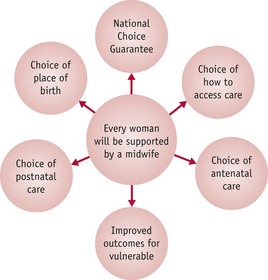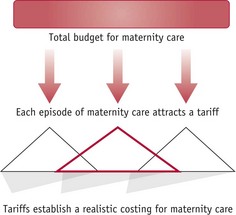Chapter 6 Leadership and management in midwifery
Learning Outcomes
By the end of this chapter, you will be able to:
Introduction
Government strategies for maternity services focus on the premise that all women and their families will have access to quality maternity services, designed to meet their individual needs (DH 2004, Scottish Office NHSiS 2001, Welsh Assembly 2005). The Maternity Services Survey (DH 2007c) revealed that 80% of women were satisfied with care they received during pregnancy and childbirth. Women also stated their preference for more choice regarding their care. In response, the Government published Maternity matters: choice, access and continuity of care (DH 2007b) with a renewed focus to improve the quality of maternity services. Safety, quality of care, choice and satisfaction are recognized as the key priorities for women and their families during their pregnancy, childbirth and postnatal experience (DH 2007b). To support its commitment to women, the Government has underpinned its strategy with a guarantee to all women regarding the quality of the care they will receive. Women will be offered choices in:
The key features of government policy are shown in Figure 6.1.

Figure 6.1 Maternity matters: choice, access and continuity of care (DH 2007b), indicating all choices are available to women.
The key to the successful implementation of the government strategy is through effective dissemination across health authorities and with stakeholders who will engage with a commitment to operationalize the strategy. Consequently, midwives need to be aware of developments in their local maternity services (DH 2007b). In order for plans to be fully implemented, resourced, sustained, monitored and evaluated, effective midwifery leadership is fundamental for this agenda for change (Scottish Office NHSiS 2001). Additionally, the financial cost of maternity services must be accurately and realistically assessed so that resources may be provided for effective and efficient management (DH 2007b). In order to assess resources, each episode of maternity care – for example, an antenatal visit, delivery by caesarean section or normal postnatal inpatient care over a 24-hour period – is allocated a specific cost (tariff), thereby influencing the funding of resources (Fig. 6.2). The cost may be allocated regardless of geographical location but will need to take account of social issues that affect the resources required by women in the maternity services.
Whilst leadership and management of maternity services have been devolved, there are developments for national standards and objective monitoring frameworks to ensure quality of care and equity of provision for all women across the United Kingdom (DH 2007b). Improving the care given to women and their families is through preparation of the maternity services workforce, with investment in staff development and education (DH 2007b, Scottish Office NHSiS 2001). Midwife leaders and managers at each health service level are required and need to be prepared for their roles in management and leadership.
Whilst their role, responsibility and accountability is to ensure the quality and safety of care for women during pregnancy, childbirth and the postnatal period, midwives require leadership and management skills as key aspects of their role (Fig. 6.3). Midwives need to develop a critical insight and understanding of the theory and practice of leadership and management and its application to their practice, regardless of whether their practice is in the health service or independent sector. Acquiring leadership and management knowledge and skills will enhance effectiveness in the development of quality maternity services and the progression of the midwifery profession in the 21st century and beyond. Figure 6.3 shows how the functions within their role overlap.
The development of leadership and management theory
In leadership and management, there are variations in use and application of terminology. There are examples of literature where the terms management and leadership are used synonymously (Buchko 2007, Manning 2002, Muldoon & Miller 2005, Nienaber & Roodt 2008), and where the term management is used primarily with some reference to leadership (Ollila 2008, Ozcelik et al 2008, Pounder & Coleman 2002, Prosen 2008, Sadler-Smith & Shefy 2006), and where the term leadership is used predominantly. These sources identify the role of the leader as having primacy, with need for additional skill development in the management of resources (Buchanan et al 2007, Greenfield 2007, Guillory 2007a, Guillory 2007b, Hammett 2008, Turner & Mavin 2007, Wood & Winston 2007). Ackloff (1981) argues that the principles of leadership and management are interwoven, proposing an effective leader has to gain legitimacy, which is acquired through previous resource management success. A further degree of clarification is offered by French et al (2008), who suggest a simple distinction between management and leadership. The role of a manager within an organization is concerned primarily with ensuring stability and enabling the organization to run effectively. The role of a leader within an organization is to inspire the workforce and promote innovation and long-term change.
In making distinctions between the role of leader and manager, French et al (2008) indicate that the senior person is identified as leader. This distinction is useful in concepts for strategic and operational leadership and management terminology, for example, the strategic leader is considered the visionary and the most senior post, the operational manager ensures the effective utilization of resources to sustain the business. However, it is important to acknowledge that size and complexity in organizations may determine their leadership and management roles and responsibilities.
The terms strategic and operational appear to be widely utilized by organizations in determining a leadership and management hierarchy. Nonetheless, the roles of leader and manager are neither distinct nor clearly demarcated, and overlaps between the two are perhaps inevitable and unavoidable (Adair 2006). As the understanding of leadership and management has developed, it is increasingly acknowledged that the role of manager requires leadership skills regardless of the level of the management role within an organization (Adair 2006).
Leadership
Adair (2006) advocates the use of the term leadership and suggests there are three levels of leadership (Fig. 6.4):
Whilst leadership theory has evolved since the beginning of the 20th century (Yukl 2005) and effective leadership is a key facet of an organization’s success, there is lack of clarity regarding what is an effective leader; however, what is clear is that there is no single style of leadership that works in all situations. Growing organizational complexity necessitates alternative leadership strategies to gain insight into the management of understanding and the principles of effective leadership (Ackloff 1981, Yukl 2005). Ackloff (1981) coined the term ‘contextual mess’ to describe the increasing complexity of work environments. Within an organization’s contextual mess and the complexity of health services, maternity services leaders and managers are faced with multifaceted challenges which appear to be underpinned by ambiguity, uncertainty and shifting priorities.
Traditional theories of leadership
Trait theory
Trait theory is considered the earliest documented approach of the study of leadership and can be plotted back to the early 20th century (French et al 2008). This theory attempts to capture the traits of recognized leaders in history, for example Napoleon and Churchill, and apply these traits to identify future leaders. Stogdill (1974) argued that there are specific identifiable traits which are linked to leadership success. These specific traits can be identified in leaders working within a wide range of professions and disciplines, including military services, law, business organizations and politics. Whilst research succeeded in the recognition of a number of common behaviours of established leaders, including charisma, intelligence and effective communication skills, it failed to recognize that there were also exceptions to the possession of these identified traits to be found amongst other successful leaders (Bass 1990, Stogdill 1974) (Fig. 6.5). Little consideration was given to the context of the situation in which a leader may find themselves, for example the difference between leading an independent midwifery group practice and a midwife leading/managing a maternity unit of over 9000 deliveries per annum. The skills of a leader may be situation- or context-specific.
Behavioural theory
In the 1950s, theorists considered a behavioural approach to leadership, through studying behaviours demonstrated by recognized leaders (French et al 2008). The theory suggested that an effective leader demonstrates specific behaviours and that leadership and effective resource management were central to maintenance and development of a successful organization. This could be applied to leadership and management in midwifery. Two research studies revealed two key behaviours of effective leadership (Bass 1990, Likert 1961):
Research into leadership identified that a distinct leadership style was of an employee-centred approach, and a second a production-centred approach. Effective performing organizations demonstrated high levels of employee-centred leadership. Leaders who were employee-centred demonstrated a higher level of production with a greater degree of employee satisfaction and positive morale (Likert 1961). Leadership behaviours were considered in terms of ‘human-relations-orientated’ or ‘task-orientated’ (Likert 1961). It was not clear from the results whether any of the organizations examined demonstrated leaders utilizing both distinct behaviours simultaneously or separately within the same organization and the potential impact on either employee or production.
An Ohio State University research study examined perceptions of leadership styles amongst the most senior organization staff. It revealed that leaders who were considerate to the feelings of employees or junior staff were deemed to be the more successful leaders. Those leaders who were orientated to the achievement of the task were less popular and did not maintain staff morale. The research later concluded that the most successful leaders demonstrated both behaviours, they were considerate of the workforce and their needs and also remained task-focused (Bass 1990).
Alternative leadership styles
Transformational leadership
Transformational leadership is determined by a leader demonstrating key characteristics, including charisma, and the ability to inspire and motivate staff in the achievement of a shared vision or goal. Through these characteristics, a leader will gain the trust and confidence of employees. Successful transformational leadership ensures the organization benefits from enhanced employee commitment and performance. Transformational leadership creates changes in an organization which can present the greatest challenges as the outcome of change cannot be fully predicted (Ackerman 1986). In a transformational change, reciprocal levels of trust and confidence are required between the workforce and the leader (Jick 1993). Therefore, leading changes in maternity services involves teamwork and staff participation.
Implementing transformational leadership may highlight a range of issues, such as unpredicted emotional behaviours, which challenges a leader’s self-awareness and the prospect of failure (Mitki et al 2008). Early recognition of unpredicted or adverse outcomes such as resistance of staff or the effects of changing a rostering pattern on part-time staff need to be addressed during a change process. The transformational process can be effective as it facilitates the leader’s positive influence over colleagues (Bass 1998). If managed effectively, change can result in individual and team performances beyond expectation with recognition by colleagues of effective transformational leadership in both the management of resources and productivity.
Stay updated, free articles. Join our Telegram channel

Full access? Get Clinical Tree






